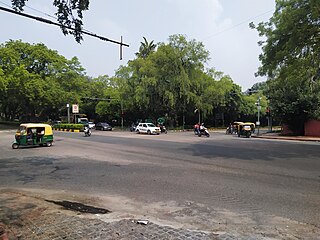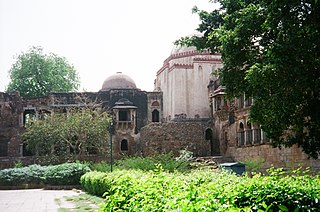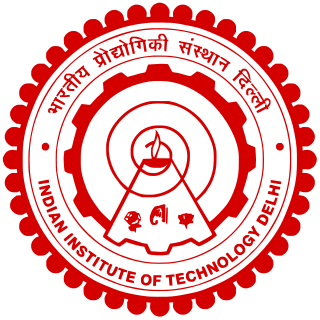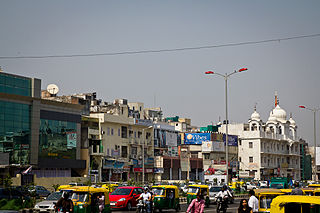
Paharganj is a neighbourhood of Central Delhi, located just west of the New Delhi Railway Station. Known as Shahganj or King's ganj or market place during Mughal era, it is one of the three administrative subdivisions, of the Central Delhi district, of the National Capital Territory of Delhi, with the other two being, Darya Ganj and Karol Bagh.

Deer Park also known as Aditya Nath Jha Deer Park, is a natural park in Delhi located in the subdivision of Hauz Khas in South Delhi. It was named after famous social worker Aditya Nath Jha. This place is popular for walking, jogging and weekend outings. Deer Park comprises many subsections such as Duck Park, Picnic Spots Rabbit Enclosures etc. The park is accessible from Safdarjung Enclave and Green Park, Hauz Khas Village. It is also connected to District Park thus making it approachable from R K Puram near the courts side of the Delhi Lawn Tennis Association.

Lodhi Road in New Delhi, India, is named after the Lodhi Gardens located on it. Two Mughal mausoleums, Humayun's Tomb and Safdarjung's Tomb, lie at the eastern and western ends of the road respectively. A number of cultural, educational, and international institutions line the road. The Jor Bagh metro station lies under Aurobindo Marg near its intersection with Lodhi Road. Also located near it are Lodhi colony and Lodhi Estate built during British Raj in 1940s, and Lodhi Road Institutional Area.

Saket is a residential colony and the administrative headquarters of the South Delhi district of Delhi in India. The neighborhood is named after the city of Ayodhya, also known as Saket, an ancient, religiously significant city in Uttar Pradesh. Saket has four major malls on the Press Enclave Marg. The neighbourhood is home to the first Apple Store, called the Apple Saket, in New Delhi and the second in India, after Apple BKC located in Bandra Kurla Complex of the financial centre of the country, Mumbai.

Hauz Khas Complex in Hauz Khas, South Delhi houses a water tank, an Islamic seminary, a mosque, a tomb, and pavilions built around an urbanized village with medieval history traced to the 13th century of Delhi Sultanate reign. It was part of Siri, the second medieval city of India of the Delhi Sultanate of Alauddin Khalji Dynasty (1296–1316). The etymology of the name Hauz Khas in Persian is derived from the words ‘Hauz’: "water tank" and ‘Khas’:"royal"- the "Royal tank". The large water tank or reservoir was first built by Allauddin Khilji to supply water to the inhabitants of Siri. The tank was de–silted during the reign of Firuz Shah Tughlaq (1351–88). Several buildings and tombs were built overlooking the water tank or lake. Firuz Shah's tomb pivots the L–shaped building complex which overlooks the tank.

Safdarjung area consists of mainly two localities in South Delhi, namely Safdarjung Enclave and Safdarjung Development Area (SDA). There are several districts in Delhi located south of the tomb of Safdarjung, the second Nawab of Awadh, an important administrator in the Mughal Imperial courts in Delhi, under Muhammad Shah in the 18th century.

South Delhi is an administrative district of the National Capital Territory of Delhi in India with its headquarters in Saket. Administratively, the district is divided into three subdivisions, Saket, Hauz Khas, and Mehrauli. It is bounded by the Yamuna River to the east, the districts of New Delhi to the north, Faridabad District of Haryana state to the southeast, Gurgaon District of Haryana to the southwest, and South West Delhi to the west.

IIT Delhi, officially the Indian Institute of Technology Delhi, is a public institute of technology located in Delhi, India. It is one of the 23 Indian Institutes of Technology created to be Centre of Excellence for India's training, research and development in science, engineering and technology.
INA colony is a residential colony maintained by the Airports Authority of India for their employees. It was named after a former private airline, Indian National Airways, which was amongst those nationalised and merged to form, Indian Airlines in 1953.

Sri Aurobindo Marg or Aurobindo Marg, is an important South Delhi north-south arterial road connecting historic Safdarjung's Tomb to Qutab Minar. The road is named for Sri Aurobindo Ghosh; the Delhi campus of Sri Aurobindo Ashram is located on the road. The road was originally known as Mehrauli Road.
Malviya Nagar is a residential locality in South Delhi with property prices over 17,000 per sqft. Situated between Saket and Hauz Khas and close to IIT Delhi, its namesake is the freedom fighter Madan Mohan Malviya.
Yusuf Sarai is a locality in South Delhi. It lies on the Sri Aurobindo Marg close to AIIMS, New Delhi, and accommodates both residential as well as market places. It is named after historic Yusuf Sarai, one of many sarais which were built in area during and Delhi Sultanate period, including, Katwaria Sarai, Lado Sarai, Sheikh Sarai and Kallu Sarai.

Chor Minar or 'Tower of Thieves' is a 13th-century minaret with 225 holes, situated just off Aurobindo Marg in the Hauz Khas area, in New Delhi. The Chor Minar is nearly 700 to 800 years old. it's also situated in narnaul Haryana near dhosi hills 120 km away from Delhi

Siri Fort, in the city of New Delhi, was built during the rule of Alauddin Khalji, second ruler of Khalji Dynasty, of Delhi Sultanate to defend the city from the onslaught of the Mongols. It was the second of the seven cities of medieval Delhi built around 1303, which at present is seen only in ruins with a few remnants due to its poor quality construction as compared to previous fort constructions in India (pictured).

Jahanpanah was the fourth medieval city of Delhi established in 1326–1327 by Muhammad bin Tughlaq (1325–51), of the Delhi Sultanate. To address the constant threat of the Mongols, Tughlaq built the fortified city of Jahanpanah subsuming the Adilabad fort that had been built in the 14th century and also all the establishments lying between Qila Rai Pithora and Siri Fort. Neither the city nor the fort has survived. Many reasons have been offered for such a situation. One of which is stated as the idiosyncratic rule of Mohammed bin Tughlaq when inexplicably he shifted the capital to Daulatabad in the Deccan and came back to Delhi soon after.

Green Park is an upscale affluent neighborhood in South Delhi, India. The locality is divided into two parts i.e. Main and Extension. The neighbourhood registered a 4.4% growth in residential sales and was featured alongside Greater Kailash, Defence Colony, Vasant Vihar and Anand Niketan in the 2019 edition of Knight Frank's quarterly report on prime luxury residential properties in various megacities around the globe. Property rates have always been high in this colony due to the numerous facilities available. Builder floors and independent villas cost anywhere between INR 6–70 crores in this colony. Rental rates are also very high making this residential area among the most expensive pin codes of New Delhi.
Gulmohar Park is a neighbourhood in South Delhi. This park lies between Hauz Khas and Gautam Nagar and is named after the red-flowered Gulmohar trees growing inside. The nearby residential colony is known as Gulmohar Park Journalists' Colony or simply Gulmohar Park for short, and was established by a group of journalists in the 1970s and is today home to business people, senior lawyers and cine star Amitabh Bachchan's Delhi residence.
Gulmohar Enclave is a posh neighborhood in South Delhi. It is adjacent to Gulmohar Park. It is a colony of 300 apartments and was constructed in 1983 by the Delhi Development Authority. It is now owned by the residents.

The Hauz Khas metro station is an interchange station between the Yellow Line and the Magenta Line of the Delhi Metro. It serves Hauz Khas Enclave, Sarvapriya Vihar, Vijay Mandal Enclave, RBI colony, Mayfair Gardens and the IIT Delhi. The entrance to the station is located on Outer Ring Road, to the east of Aurobindo Marg and to the west of Khelgaon Marg.

























